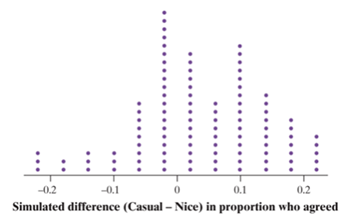
Concept explainers
(a)
To find: the difference in the proportion of subjects which agreed to allow in the survey in the two groups.
(a)
Answer to Problem 108E
-0.26
Explanation of Solution
Given:
| Casual | Nice | |
| Agreed | 14 | 27 |
| Declined | 36 | 23 |
Calculation:
First find the column totals
| Casual | Nice | |
| Agreed | 14 | 27 |
| Declined | 36 | 23 |
| Total | 50 | 50 |
The proportion of subjects that allow participating is then the count in the “Agreed” row of the table divide by the column total.
Casual:
Nice:
The difference in proportions (Casual − Nice) is then the proportion of Casual decreased by the proportion of Nice:
(b)
To find: the differences in proportions would get due only to possibility variation in this arbitrary assignment.
(b)
Answer to Problem 108E
Not statistically significant
Explanation of Solution
Given:

The dots in the given dot plot shows the simulated difference (Casual −Nice)
In the proportion who agreed. It is observed that 0 lies in the mid of the bulk of dots in the dot plot that shows that a difference in proportions of 0 is likely to occur.
Although 0 is likely to get, the difference not statistically significant if 0 would have been not likely to occur, then the difference would have been statistically significant.
(c)
To find: the flaw in the design of this experiment would prevent from drawing a cause-and-effect conclusion about the affect of an interviewer’s attire on non response in a survey.
(c)
Answer to Problem 108E
The treatments were not randomly assigned to the subjects.
Explanation of Solution
Two variables are confounded when their effects on a response variable could not be distinguished from each other.
In this case, it could not be concluded that there is cause- and-effect, because the treatments were not arbitrary assigned to the subjects as they wore casual clothes on one day and nice clothes on the other day.
This then means that the day on which they wore the clothes could affect the results and therefore it could not be distinguish the day from the treatments.
Chapter 5 Solutions
PRACTICE OF STATISTICS F/AP EXAM
Additional Math Textbook Solutions
Elementary Statistics
Essentials of Statistics (6th Edition)
Elementary Statistics: Picturing the World (6th Edition)
Basic Business Statistics, Student Value Edition (13th Edition)
Elementary Statistics Using Excel (6th Edition)
Fundamentals of Statistics (5th Edition)
 MATLAB: An Introduction with ApplicationsStatisticsISBN:9781119256830Author:Amos GilatPublisher:John Wiley & Sons Inc
MATLAB: An Introduction with ApplicationsStatisticsISBN:9781119256830Author:Amos GilatPublisher:John Wiley & Sons Inc Probability and Statistics for Engineering and th...StatisticsISBN:9781305251809Author:Jay L. DevorePublisher:Cengage Learning
Probability and Statistics for Engineering and th...StatisticsISBN:9781305251809Author:Jay L. DevorePublisher:Cengage Learning Statistics for The Behavioral Sciences (MindTap C...StatisticsISBN:9781305504912Author:Frederick J Gravetter, Larry B. WallnauPublisher:Cengage Learning
Statistics for The Behavioral Sciences (MindTap C...StatisticsISBN:9781305504912Author:Frederick J Gravetter, Larry B. WallnauPublisher:Cengage Learning Elementary Statistics: Picturing the World (7th E...StatisticsISBN:9780134683416Author:Ron Larson, Betsy FarberPublisher:PEARSON
Elementary Statistics: Picturing the World (7th E...StatisticsISBN:9780134683416Author:Ron Larson, Betsy FarberPublisher:PEARSON The Basic Practice of StatisticsStatisticsISBN:9781319042578Author:David S. Moore, William I. Notz, Michael A. FlignerPublisher:W. H. Freeman
The Basic Practice of StatisticsStatisticsISBN:9781319042578Author:David S. Moore, William I. Notz, Michael A. FlignerPublisher:W. H. Freeman Introduction to the Practice of StatisticsStatisticsISBN:9781319013387Author:David S. Moore, George P. McCabe, Bruce A. CraigPublisher:W. H. Freeman
Introduction to the Practice of StatisticsStatisticsISBN:9781319013387Author:David S. Moore, George P. McCabe, Bruce A. CraigPublisher:W. H. Freeman





